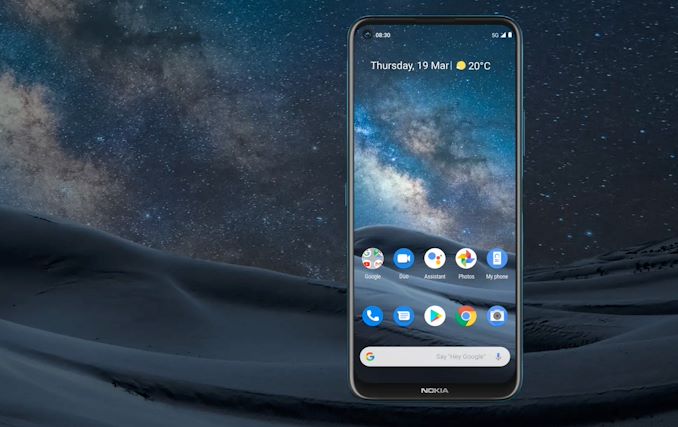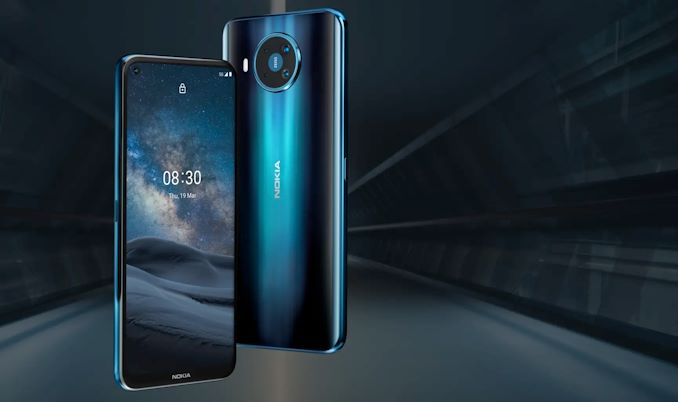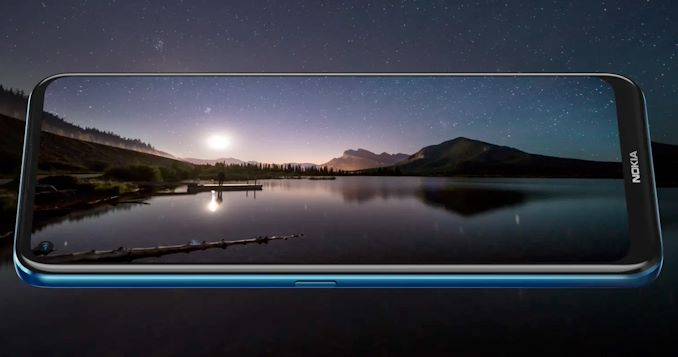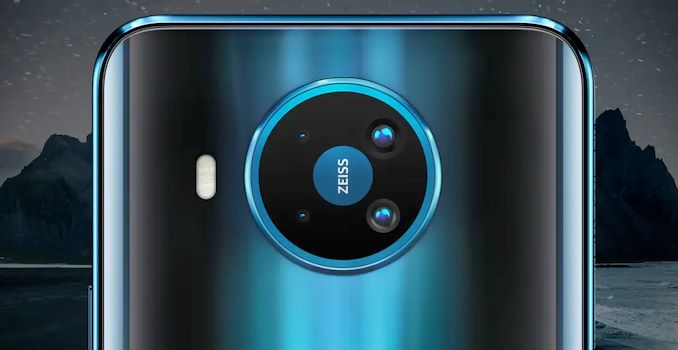HMD Debuts First Nokia 5G Smartphone: The Nokia 8.3 5G with 4-Module Camera
by Anton Shilov on March 20, 2020 6:15 PM EST- Posted in
- Smartphones
- Nokia
- Mobile
- 5G
- HMD Global
- Snapdragon 765
- Snapdragon 765G

HMD Global has announced their first Nokia-branded 5G-enabled smartphone, the Nokia 8.3 5G. Based on Qualcomm’s Snapdragon 765G platform, Nokia is assembling a high-end smartphone that is designed to tick all of the required boxes for a good phone, while not driving quite as hard on features and prices as contemporary flagship smartphones. None the less, the large display phone packs a quad-sensor camera module, and in an interesting turn of events, it will support more 5G bands than other handsets on the market today.
Once released, the Nokia 8.3 5G will be one of the first handsets launched in the West that's based on Qualcomm’s Snapdragon 765G system-on-chip, an interesting chip that, unlike the flagship Snapdragon 865, uses a fully integrated 5G modem. Furthermore, the 8.3 5G will be the very first phone that uses Qualcomm’s own 5G RF front-end module, a potentially important distinction as Qualcomm's front-end supports a greater number of bands than other modules already on the market. As a result the 8.3 5G is being pitched as a "truly global" smartphone that should be able to work in most countries despite the wide disparity in which bands are used.
Otherwise, while the Snapdragon 765G is not Qualcomm’s flagship SoC, the recently-launched chip is still decidedly capable. The SoC uses two Cortex-A76 based CPU cores for high intensity workloads as well as a further six Cortex-A55 cores for low intensity workloads, and packs Qualcomm's Adreno 620 integrated GPU. For the Nokia 8.3 5G, this is paired with 6 GB or 8 GB of LPDDR4X memory, as well as 64 GB or 128 GB NAND flash memory.
The first 5G Nokia handset comes with a large 6.81-inch IPS LCD with PureDisplay enhancements (deeper blacks, less reflections), and offers a 2400×1080 resolution (386 PPI). Oddly, however, HMD lists nothing about support for the DCI-P3 or HDR10 support, despite the fact that the company has supported HDR on earlier Nokia 7 and Nokia 8-series smartphones.
Instead, it's imaging capabilities are often the strongest side of Nokia handsets, and HMD is aiming similarly high here. The Nokia 8.3 5G comes with a quad-sensor main camera module comprised of a 64 MP main sensor, a 12 MP ultrawide sensor, a 2 MP macro camera, and a 2 MP depth sensor. Nokia says that the main camera is tuned for better operation in low-light conditions and has some additional enhancements by Zeiss, who is also certifying the lenses. As for selfies, the smartphone has a punch-hole 24 MP camera on the front. And audio recording is provided via a Ozo surround audio microphone array.
When it comes to wireless connectivity, the Nokia 8.3 5G smartphone supports Wi-Fi 5, Bluetooth 5.0, and NFC. Meanwhile, the handset has a headphone jack as well as a USB 2.0 Type-C connector for data connectivity and charging. As for security, the device carries a fingerprint reader on its side.
Nokia’s handsets are known for their fine industrial design, so the Nokia 8.3 5G is clearly not an exception. The device has a rounded back and comes in Polar Night color that was inspired by Aurora Borealis usually seen in Norther Finland. Meanwhile, the phone is rather thick at nearly 9 mm and heavy at 220 grams. Otherwise, it should be noted that HMD isn't listing the phone as offering any IP-grade water or dust resistance.
| The Nokia 8.3 5G | ||||
| Nokia 8.3 5G 6/64 |
Nokia 8.3 5G 8/128 |
|||
| SoC | Qualcomm Snapdragon 765G 1x Kryo 475 Prime (A76) @ 2.40 GHz 1x Kryo 475 Gold (A76) @ 2.20 GHz 6x Kryo 475 (A55) @ 1.80 GHz |
|||
| GPU | Adreno 620 | |||
| DRAM | 6 GB LPDDR4X | 8 GB LPDDR4X | ||
| Storage | 64 GB microSD |
128 GB microSD |
||
| Display | 6.81" IPS LCD PureDisplay 2400 × 1080 (20:9) 386 PPI |
|||
| Size | Height | 171.90 mm | ||
| Width | 78.56 mm | |||
| Depth | 8.99 mm | |||
| Weight | 220 grams | |||
| Battery Capacity | 4500 mAh | |||
| Wireless Charging | ? | ? | ||
| Rear Cameras | ||||
| Main | 64 MP f/1.7 PDAF |
|||
| UltraWide | 12 MP 1/2.4" f/2.2 13mm ?° field of view |
|||
| Macro | 2 MP | |||
| Depth | 2 MP | |||
| Flash | Dual-LED | |||
| Front Camera | 24 MP f/2.0 |
|||
| I/O | USB 2.0 Type-C Fingerprint reader on the side Google Assistant button |
|||
| Wireless (local) | Wi-Fi 5 Bluetooth 5.0 |
|||
| Cellular | GSM, CDMA, HSPA, 4G/LTE (1200/150 Mbps), 5G (2.4/1.2 Gbps) | |||
| Splash, Water, Dust Resistance | ? | ? | ||
| Dual-SIM | Single nano-SIM or Dual nano-SIM | |||
| Launch OS | Android 10 | |||
| Launch Price | €599 | €649 | ||
HMD plans to make its Nokia 8.3 5G available this summer. The more affordable version with 6 GB of RAM and 64 GB of NAND will cost €599, whereas the more advanced model with 8 GB of RAM and 128 GB of NAND will be priced at €649.
Related Reading:
- Nokia 8.1 Unveiled: Elegant Phone with 6.18-Inch Display, 20MP Selfie Cam, Zeiss Optics
- Nokia 7.2 Launched: 6.3-Inch PureDisplay, 48MP Camera, Snapdragon 660
- Nokia 7.1 Smartphone Launched: 5.84-Inch ‘PureDisplay’, Zeiss Optics
- Nokia Launches Nokia 9 PureView at MWC 2019: So I Heard You Like Cameras
Sources: HMD Global, GSMArena














39 Comments
View All Comments
shabby - Friday, March 20, 2020 - link
Lol €649 for a mid range soc, good luck with that nokia.KarlKastor - Saturday, March 21, 2020 - link
The SoC is the best of the phone.The cameras are far worse. Two tiny sensors without any benefit. Maybe the Ultra wide is useful.
That setup u find normally in the 200€ region.
And that bezel at the bottom....
This phone is huge.
BedfordTim - Saturday, March 21, 2020 - link
Lets not forget the quality of their support. They still haven't fixed the focus and missing photo bugs on the Nokia 9 and their user reviews of other models are equally dire.Viipottaja - Saturday, March 21, 2020 - link
Sure. Which 5G phones are €200 again?yeeeeman - Saturday, March 21, 2020 - link
That "midrange" SoC is basically a Snapdragon 855 with a tad slower clocks.Arnulf - Saturday, March 21, 2020 - link
Not true - Snapdragon 855 has 4 fast (A76, OOo) cores, one of which can run at even higher frequency, along with 4 slower (A55, Io) cores.Snapdragon 765 only has two faster (A76, OOo) cores along with 6 slower (A55, Io) cores.
Saying that he two are almost the same save for tiny difference in operating frequency is like saying that 6 cylinder engine is almost the same as 4 cylinder engine with same per-cylinder displacement, save for slightly lower RPM.
ajp_anton - Saturday, March 21, 2020 - link
That car engine thing isn't a fair comparison. Many tasks aren't that multithreaded, so in singlethreaded tasks they are fully comparable (except for clock speeds).close - Saturday, March 21, 2020 - link
How many phones have efficient enough cooling to ave those 4 fast cores actually operate at high freq, with 1 of them at 2.83GHz even? The reality is that while some SoCs look great on paper, in most implementations they are used just for bragging rights. The cores will throttle. Look at the benchmarks where the reviewer keeps the phone on a cold plate vs. no cooling.So in most practical scenarios the usefulness is only in bursts and 2 fast cores with 6 slower cores will behave very similarly. There may be cases where differences are visible but in most cases the 855 is overkill. Like the 10+ core SoCs some reviewers insisted are the future. This way you may get the chance of being more efficient with the battery.
shabby - Saturday, March 21, 2020 - link
Would you pay $700 usd for a mid range soc? This is pixel 3a type of phone yet its almost twice the price.close - Tuesday, March 24, 2020 - link
Because it's not a "mid-range SoC" (it's positioned slightly below the 865 and you'd be hard pressed to tell the difference between the 2 in real life scenarios) and the top of the line SoC goes in phones that *start* at $1000. That's because the 865 needs a separate 5G chip, eats a lot of power, produces a lot of heat, so it goes into big, really expensive phones. I invite you to check the prices of the Galaxy S20 or Sony's Xperia 1 II and compare with the price of their predecessor and you'll (maybe) understand why "ermahgerd! mid range!!" is not what it looks like.The 765 is the first with an integrated 5G modem. It loses a bit on the performance side but nothing you'd notice if you care about more than the specs on the box and gains a lot with better power consumption, heat generation, and far lower board complexity.
765 phones aren't cheaper because it's a "mid-range SoC", they're cheaper because of everything else. There's a reason Google isn't really planning an 865 based phone this year. Nobody cares about that extra performance it brings (save for the warm fuzzy feeling they get when looking at the box) and it comes with so many drawbacks that it's a hard sell.
But it looks to me like this comment thread is full of people who can just compare numbers. "Starts with 7 is smaller than 8... is shit yo".